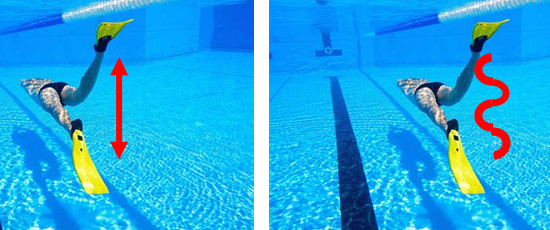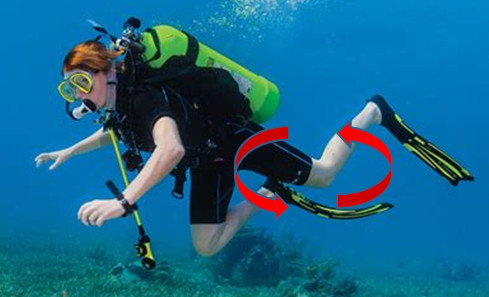
Choosing Fins For Efficient Underwater Swimming
by
Larry "Harris" Taylor, Ph.D.
This
material is copyrighted and all rights retained by the author. This article is
made available as a service to the diving community by the author and may be
distributed for any non-commercial or Not-For-Profit use.
All rights reserved.
Go To: Home About "Harris" Articles Slides War Stories Editorials Links Fini
It is important to realize that when swimming underwater, "power" (speed / forward thrust or motion) comes from the leg muscles. Power does not come from fins as fins simply convert leg muscle expended energy to forward motion. When introducing fin use at the first pool session, I have my students feel the size of their wrist, forearm, biceps, calf, and lastly their thigh muscles. Then, I ask, which muscle is largest? Obviously, it's the thigh muscle. So, the best source of underwater swimming power is the thigh muscles. Using any other
muscle is less efficient (more wasteful of breathing gas) and often a predisposition to muscle cramps. Thus, the best muscle system to use when swimming underwater is the thigh muscles.
The leg-fin combination can be envisioned as a lever arm for converting thigh muscle strength to forward motion. This suggests the best swimming technique is with the legs as long and as straight as possible to maximize this lever action. The ankles should be extended to point backwards. (see
Visualizing Proper Kick ). In other words, the fins
are merely transducers that convert leg muscle strength / energy to forward propulsion.
Importantly, this extended leg posture utilizes the thigh muscle as the primary
driving force.
In general, the stiffer the fin, especially with high sides (to limit side-to-side movement), the more efficient this power transfer and the greater the forward propulsion per flutter kick stroke. But,
if the leg muscles are not strong enough to drive the fins, then the stiffness of the fins will promote increased fatigue, cramping, and shorter bottom time.
If using a fin too flexible for the leg muscles, putting power to the fin will simply fold the fin and muscle effort is
wasted and propulsion is decreased.
Finally, there should be a snug fit between the diver's foot covering and the fin 'cause a loose fit wastes power and may promote fin loss while too snug a fit makes removing the fin in open water a bit problematic. (i.e. I use different sized fins depending on whether I am driving wet or dry)
There is an abundance of dive fins available today. No single fin is best for all
divers in all possible diving situations / equipment configurations. This means divers will have to evaluate fins to determine a good fin/leg muscle match.
This evaluation is best done swimming in a pool or high visibility open water with another diver to observe the fin action while swimming.
From behind:
The fins should move in a vertical up and down movement (below, left) giving thrust on both up and downward strokes. If the fins are too stiff for the diver's leg muscles, the fin movement will meander (slip) from side to side during the kick stroke (below right). If this "slippage" movement is observed, the swimming diver should consider a smaller, less rigid fin.

From the side:
The legs should be extended, without locking the knees, as straight as possible (again, see
Visualizing Proper Kick). Typically, a poor kick (often from leg-fin mismatch) will appear as if the diver were riding a bicycle (a circular motion about the knees ... hence its name, the "bicycle kick" see below). This is extremely inefficient and
can add excessive stress on the knee joint. Calf muscle cramping is often a
result of this bicycling motion.
If extending the legs in a more proper kick stroke does not eliminate the bicycle, then the diver should consider a less stiff fin.

Additional comments:
Using hands as propulsion underwater is extremely inefficient and wastes enormous amounts of breathing gas. In addition this arm movement tends to create convection currents that rapidly move loose bottom material into the water column with extreme decreases in visibility. Best to swim in a more streamlined position with arms / hands straight down the diver sides. One technique to minimize arm/hand movement is to swim with hands on the thighs, This streamlines swimming position (less drag) and allows the diver to feel the leg motion of the thigh muscles. (In open water, I have doubled and tripled novice diver bottom time by convincing them to restrict unnecessary arm/hand movements.)
Lastly, I am not a fan of diving fins that contain large openings. These openings allow water to flow thru the fin
adding little, if any, propulsion. More importantly, I have observed objects
(particularly steel construction rods) protrude through these openings (pinning the diver to the
bottom ... in strong current this has led to loss of the impacted fin). I once
observed a descending diver on a night dive impale their fin on another diver's
first stage.
Bottom line: Its best to match fin to leg muscles (for less fatigue, minimization
of calf muscle cramps, and
extended bottom time). This evaluation is best confirmed by observation and experience 'cause no fin is perfect for all divers in all situations.
Go To: Home About "Harris" Articles Slides War Stories Editorials Links Fini
Copyright 2001- 2026 by Larry "Harris" Taylor
All rights reserved.
Use of these this web site contents for personal or organizational profit is specifically denied.
Contents may be used for not-for-profit diving education